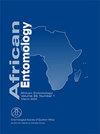南非外来入侵禾本科(禾本科)生物防治进展与展望
IF 1.2
4区 农林科学
Q3 ENTOMOLOGY
引用次数: 2
摘要
从历史上看,入侵的外来草在南非并没有被视为主要威胁,因此,很少有资源被分配给它们的管理。然而,人们越来越意识到入侵草对环境和社会经济的严重影响,以及对其进行控制的适当管理选择的必要性。南非在成功实施杂草生物控制(生物控制)以管理入侵外来植物方面有着悠久的历史,但与世界其他地区一样,入侵草并不是生物控制的主要目标。全球为数不多的草生物防治计划的实施和早期成功指标,以及草可能成为合适目标的发现,表明生物防治可能开始在管理南非入侵外来草方面发挥重要作用。在本文中,我们评估了在未来十年内针对48种草实施新型草生物防治项目的前景,这些草根据其当前的环境和经济影响被确定为风险最高。使用生物控制目标选择系统按优先级对草进行排序。五种草被优先考虑——Arundo donax L.、Cortaderia jubata(Lem.)Stapf、Cortadera selloana(Schult&Schult)AschGraebn。,毛瘤Nassella trichotoma(Hack.ex Arech.)和最大甘油(Hartm.Holmb.)。,基于使其成为合适的生物控制目标的属性。Arundo donax已经成为南非生物防治计划的目标。我们回顾了该物种生物控制方面的进展,并讨论了如何制定该计划。此外,我们概述了如何实施生物控制,以管理其余四个高度优先的目标。虽然草的生物控制并非没有挑战(例如未解决的分类法、利益冲突和缺乏支持性立法),但南非有机会从现有的全球研究中学习,并开始投资于最需要控制的高度优先物种的生物控制。本文章由计算机程序翻译,如有差异,请以英文原文为准。
Progress and Prospects for the Biological Control of Invasive Alien Grasses Poaceae) in South Africa
Historically, invasive alien grasses have not been considered a major threat in South Africa, and as a result, very few resources are allocated to their management. However, there is an increasing awareness of the severe environmental and socio-economic impacts of invasive grasses and the need for appropriate management options for their control. South Africa has a long history of successfully implementing weed biological control (biocontrol) to manage invasive alien plants, however much like the rest of the world, invasive grasses do not feature prominently as targets for biocontrol. The implementation and early indicators of success of the few grass biocontrol programmes globally and the finding that grasses can be suitable targets, suggests that biocontrol could start to play an important role in managing invasive alien grasses in South Africa. In this paper, we evaluated the prospects for implementing novel grass biocontrol projects over the next ten years against 48 grasses that have been determined to represent the highest risk based on their current environmental and economic impacts. The grasses were ranked in order of priority using the Biological Control Target Selection system. Five grasses were prioritised – Arundo donax L., Cortaderia jubata (Lem.) Stapf, Cortaderia selloana (Schult & Schult) Asch. & Graebn., Nassella trichotoma (Hack. ex Arech.), and Glyceria maxima (Hartm.) Holmb., based on attributes that make them suitable biocontrol targets. Arundo donax has already been the target of a biocontrol programme in South Africa. We reviewed the progress made towards the biocontrol of this species and discuss how this programme could be developed going forward. Moreover, we outline how biocontrol could be implemented to manage the remaining four high-priority targets. While biocontrol of grasses is not without its challenges (e.g. unresolved taxonomies, conflicts of interest and a lack of supporting legislation), South Africa has an opportunity to learn from existing global research and begin to invest in biocontrol of high-priority species that are in most need of control.
求助全文
通过发布文献求助,成功后即可免费获取论文全文。
去求助
来源期刊

African Entomology
生物-昆虫学
CiteScore
2.00
自引率
0.00%
发文量
17
审稿时长
6-12 weeks
期刊介绍:
African Entomology (ISSN 1021-3589 – print / 2224-8854 – online) replaced the old Journal of the Entomological Society of Southern Africa in 1993. A single volume consisting of two issues (March and September) is published annually. The journal is indexed in all major abstracting journals
African Entomology is a peer reviewed scientific journal that publishes original research articles and short communications on all aspects of entomology, with an emphasis on the advancement of entomology on the African continent.
 求助内容:
求助内容: 应助结果提醒方式:
应助结果提醒方式:


